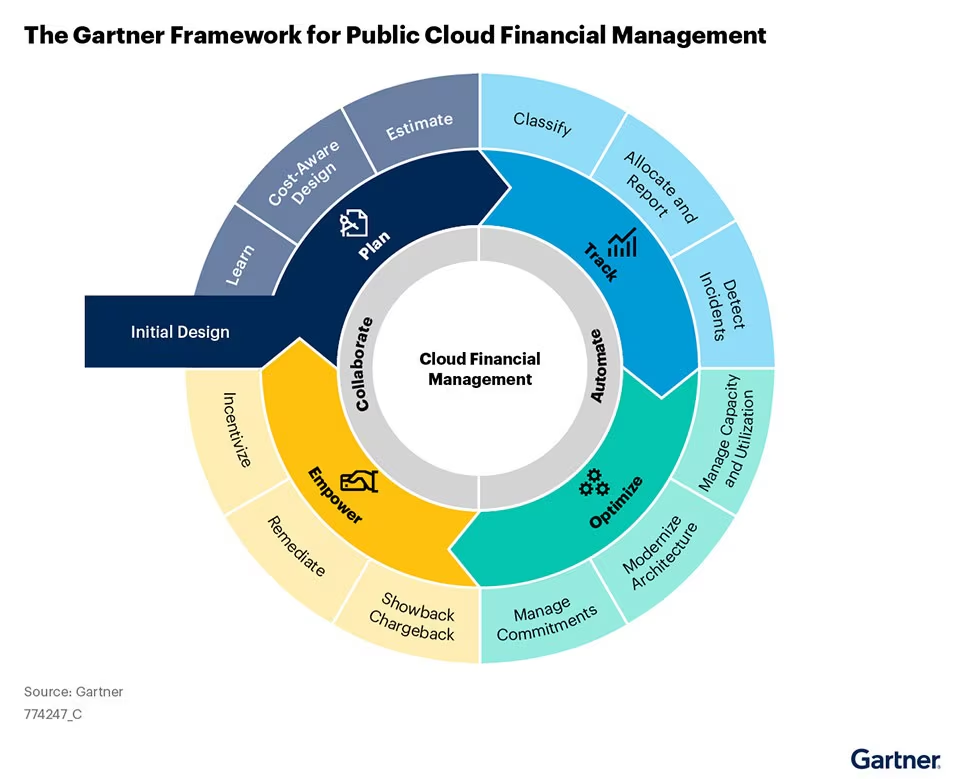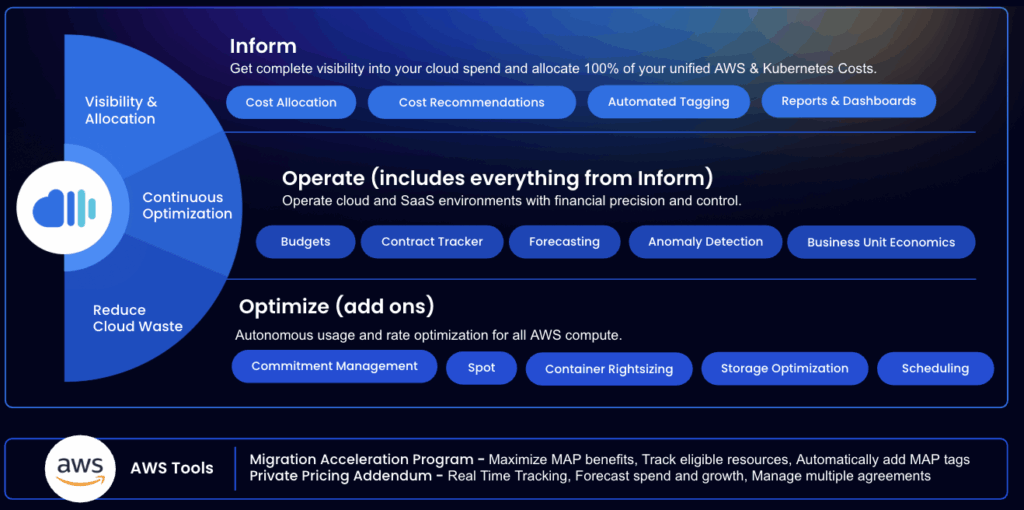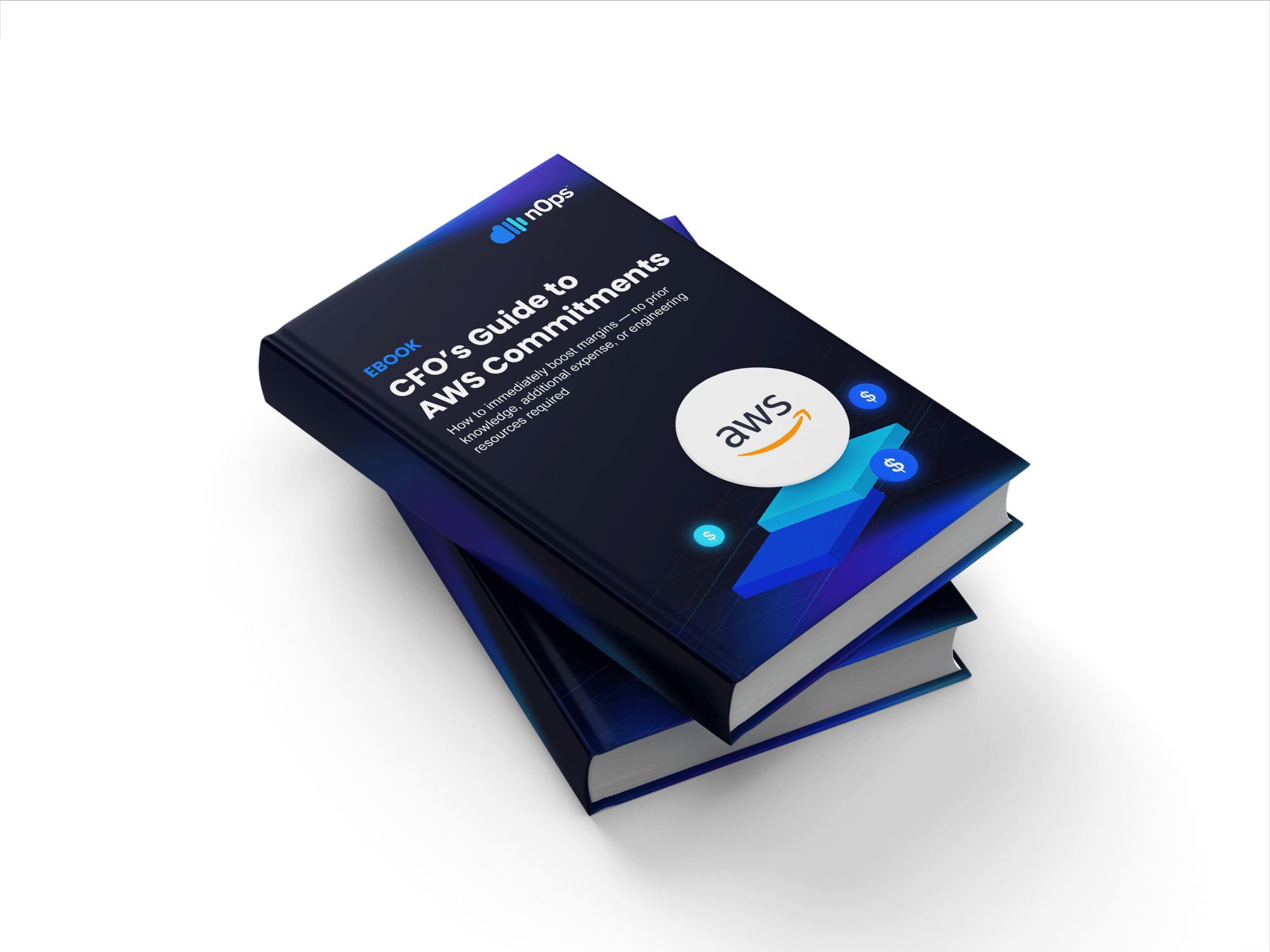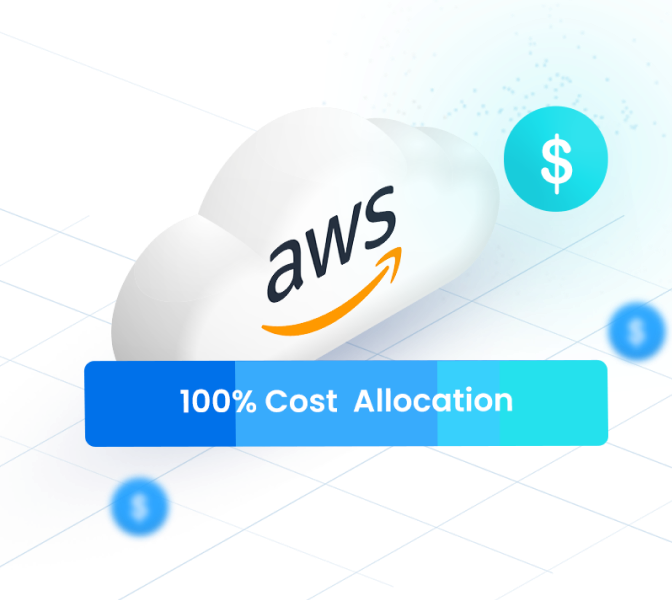The Gartner FinOps Framework: A Complete Breakdown
Cloud costs are complex, and without a solid financial management framework, they can quickly spiral out of control. Gartner’s Framework for Public Cloud Financial Management provides a structured approach to planning, tracking, optimizing, and collaborating across teams to ensure cloud spend aligns with business goals.
In this article, we’ll break down each stage of the Gartner framework, share practical FinOps tips from our experience helping teams cost-optimize, and explore how this framework compares to other FinOps approaches.

Step 1: Plan
The planning phase is where organizations lay the groundwork for effectively managing cloud costs. This is broken down into:
Learn: This stage involves building a baseline understanding of your cloud environment, including the services you’re using, their billing details, and the source of your spending. For many organizations, this involves pulling billing data, reviewing account structures, and identifying gaps in visibility, like missing tags or unknown owners for resources.
Cost-Aware Design: Here, the focus shifts to making financial impact part of design decisions. This includes standardizing resource tagging, choosing architectures that support scaling without overprovisioning, and considering factors like data transfer costs and regional pricing.
Estimate: Estimating involves forecasting cloud spend based on planned workloads and expected growth. Teams typically use historical usage data, combined with knowledge of upcoming projects, to model costs. This helps finance and engineering align budgets with reality and prepare for variability.
These three elements work best as a continuous cycle, not a one-off task. Begin with a full inventory of your environment to uncover blind spots like untagged resources or unknown owners that can derail visibility later. As you move into design, focus on preventing waste early by setting defaults for instance types, storage classes, and account structures. Forecasting doesn’t need to be perfect; it should provide a directional baseline that gives leadership enough confidence to plan budgets and understand the baseline.
Practical tips for the plan phase:
|
FinOps Tools for the Plan phase:
- CloudHealth by VMware – Helps with early tagging strategy audits, account structure reviews, and forecasting models.
- Apptio Cloudability – Supports budgeting, scenario modeling, and multi-cloud forecasting.
- nOps – Includes automated tagging, cost allocation, cost views for finance/ engineering/ leadership, filters, forecasting and budgeting. nOps offers all the features of CloudHealth and Cloudability for a lower fixed fee (CloudHealth and Cloudability charge you a percentage of your total cloud spend, which can quickly spiral cost upward).
Step 2: Optimize
The tracking phase turns cloud spending data into meaningful insights by classifying, allocating, and monitoring costs across the organization. This is broken down into:
Classify: Organize cloud resources by teams, projects, and business units to clearly identify ownership and usage patterns. This makes it easier to pinpoint which workloads drive costs and to hold teams accountable for their spending.
Allocate and Report: Develop chargeback or showback processes that give teams visibility into their share of cloud costs. By aligning costs to business units or products, organizations can foster better decision-making and financial responsibility.
Detect Incidents: Implement real-time monitoring to catch anomalies like sudden spend spikes or unexpected resource growth. Quick detection allows teams to investigate and remediate issues before they escalate into larger budget problems.
Optimization isn’t a one-time exercise but an ongoing process. It requires teams to balance cost reduction with performance needs, often making trade-offs based on workload criticality and business goals. As environments grow more complex, automation becomes essential for scaling rightsizing efforts and managing commitments effectively.
Practical tips for the track phase:
|
FinOps Tools for the track phase:
- CloudZero – Allocates costs to products, teams, or features for real-time accountability.
- Kubecost – Tracks Kubernetes costs down to namespace and pod for granular visibility.
- nOps – Includes all of the visibility features and integrations of CloudZero + Kubernetes features of Kubecost + nOps AI. The nOps AI agent can answer your cloud cost questions, detect anomalies, automate executive reporting, and recommend cost reductions — and all of this value is included at a fixed-fee level much cheaper than these other platforms.
Step 3: Track
The optimization phase is where organizations actively tune their cloud environments for efficiency and cost-effectiveness. This is broken down into:
Manage Capacity and Utilization: Continuously assess workload demands to rightsize overprovisioned resources and shut down idle environments. This includes adjusting compute, storage, and database configurations to better match actual usage.
Modernize Architecture: Transition to more cost-efficient architectures like serverless functions, containerized workloads, or managed services that reduce operational overhead and improve scalability.
Manage Commitments: Leverage commitment-based discounts such as Reserved Instances and Savings Plans, but do so with care—overcommitting can lead to unused capacity and wasted spend.
Practical tips for the optimize phase:
|
FinOps tools for the track phrase:
- AWS Compute Optimizer – Rightsizing recommendations for compute, storage, and database resources.
- Zesty – Manages commitments and storage provisioning based on usage.
- Harness Cloud Cost Management – Automates workload rightsizing and Spot Instance usage.
- ProsperOps — Manages commitments, with basic tracking and commitment visibility features.
- nOps – Automatically optimizes your commitments with a 100% utilization guarantee. Pricing is a percentage of savings, making it a no-brainer — you can only save with nOps. Also offers end-to-end optimization features beyond commitment management.
Step 4: Collaborate
The collaboration phase focuses on building shared responsibility for cloud costs across teams and empowering them to act. This is broken down into:
- Showback/Chargeback: Assign cloud costs to teams or business units through showback (visibility only) or chargeback (direct billing). This encourages ownership and highlights the financial impact of technical decisions.
- Remediate: Work with teams to address overspending and inefficiencies in a constructive way. This can include identifying architectural issues, scaling policies, or underused resources contributing to cost overruns.
- Incentivize: Recognize and reward teams that demonstrate cost-efficient behaviors, whether through performance metrics, internal recognition, or budget flexibility for future projects.
Practical tips for the collaborate phase:
|
FinOps tools for the collaborate phase:
- Atlassian Jira – Integrates FinOps cost remediation into engineering workflows with issue tracking and sprint planning.
- Slack with FinOps Bots (e.g., Cloud Custodian Alerts) – Creates real-time communication channels for cost anomalies and optimization discussions.
- PagerDuty – Routes cost-related incidents to the right teams for fast remediation and accountability.
- nOps – Most FinOps tools fall flat with engineers because they expect developers to switch context, learn a new interface, or translate from finance. nOps integrates directly with the tools developers already use — like Jira, GitHub, and GitLab — and delivers actionable recommendations, shared dashboards, team-level cost ownership views and automated reporting making it easy for engineering, finance and FinOps to collaborate.
FinOps on nOps
nOps is a purpose-built FinOps platform to help automate every single step in the FinOps framework — to help organizations reduce costs by up to 60% and reporting time by 90+%.

nOps was recently ranked #1 with five stars in G2’s cloud cost management category, and we optimize $2+ billion in cloud spend for our customers.
Join our customers using nOps to understand your cloud costs and leverage automation with complete confidence by booking a demo with one of our AWS experts.



